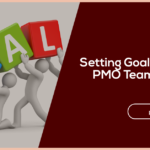Your project management office (PMO) will be unique to your industry and organisation – every business has different needs. However, there is a commonality to the PMO structure and what your team looks like no matter the exact work you do.
Starting a PMO from scratch will require you to understand how you want to break up the work. If you’re restructuring or looking to expand, knowing where you can add value or what PMO job titles are can help that process, too.
To help you figure out how to allocate the people and skills in your PMO, we’re going to look at the role and responsibilities of:
- The PMO leader or director
- Project and program managers
- Project specialists
- Project administrators or coordinators
- Project analysts or controllers
Giving you an overview now and getting into more detail about each on future posts.
The role and responsibilities of a PMO leader or director
The PMO director or leader role sits at the top of the office hierarchy and they are accountable to the PMO sponsor. It’s their job to deliver on the KPIs of the PMO, ensuring that projects are delivered on time and on budget whilst also ensuring the business goals are met.
Ideally, a PMO leader will have project management success. This has been overlooked by some businesses in the past, but it helps the leader have credibility among their team and have a real-world understanding of challenges.
Some of the key responsibilities of a PMO leader include:
- Defining the PMO, the roles within it, and managing the team
- Managing and reporting project data to their team and the C-suite
- Creating, implementing, and monitoring tools and processes
- Building relationships across the business and with suppliers
The role and responsibilities of project managers and program managers
Not every PMO will have project managers and program managers in its stable. It is becoming more common, though, as projects become more ad-hoc in nature and project skills need the be centralised.
Some of the main tasks that a project or program manager must complete include:
- Develop and plan projects, including scheduling tasks and resources
- Monitor progress of the project and find solutions to issues and bottlenecks
- Be in control of schedules and budgets
- Support, mentor, and develop project workers
Project specialist roles and responsibilities
A project specialist’s job is to support the PMs and offer them guidance to ensure they have the specialist knowledge to complete their projects. It’s generally a role found in larger PMOs and in offices where the PMs are direct reports.
A project specialist will:
- Run workshops and offer support to PMs to ensure projects can be delivered
- Facilitate learning about risk, planning, management, and working with the set methodology
- Manage professional and career development of the PMs
The work of a project administrator or coordinator
Within a PMO, a project administrator or coordinator is there to support the backend processes of a project. Their role should free up the PM and other project workers to get the project complete without worrying about paperwork.
Some key tasks of a project administrator include:
- Collecting and compiling the data to monitor the project
- Monitor scheduling issues and book resources when needed
- Track and log project expenses for reporting
The role and responsibilities of a project analyst or controller
A project controller or analyst is there to understand where the issues are in the data that has been gathered by the administrator and report to the PMO leader. They need to have a keen eye for detail and understand the processes that go into a project from initiation to close.
Some tasks that a project analyst or controller might complete include:
- Visualising the data from a project and across the PMO to spot trends and patterns
- Track the performance of people, resources, projects, and the office
- Suggest process improvements and changes when needed
The working structure of a PMO
Each PMO structure, what it looks like, and who is in charge of which tasks will vary from office to office. It’s worth understanding the different roles and how they interact with each other so you can plan or reboot your office based on best practices and with job titles that will be understandable and therefore easier to recruit for.






